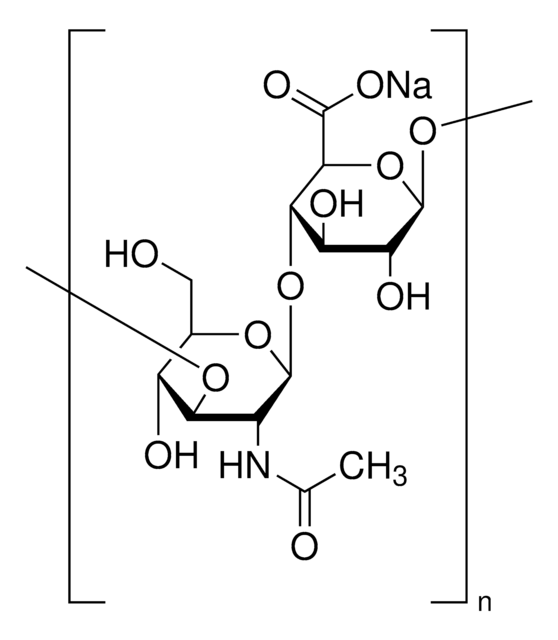おすすめの製品
形状
powder
分子量
70,000-90,000
適合性
conforms to structure for Infrared spectrum
輸送温度
wet ice
保管温度
−20°C
InChI
1S/C28H44N2O23.Na/c1-5(33)29-9-18(11(35)7(3-31)47-25(9)46)49-28-17(41)15(39)20(22(53-28)24(44)45)51-26-10(30-6(2)34)19(12(36)8(4-32)48-26)50-27-16(40)13(37)14(38)21(52-27)23(42)43;/h7-22,25-28,31-32,35-41,46H,3-4H2,1-2H3,(H,29,33)(H,30,34)(H,42,43)(H,44,45);/q;+1/t7-,8-,9-,10-,11-,12-,13+,14+,15-,16-,17-,18-,19-,20+,21+,22+,25-,26+,27-,28-;/m1./s1
InChI Key
YWIVKILSMZOHHF-QJZPQSOGSA-N
類似した製品をお探しですか? 訪問 製品比較ガイド
アプリケーション
suitable as substrate for hyaluronidase
その他情報
To gain a comprehensive understanding of our extensive range of Polysaccharides for your research, we encourage you to visit our Carbohydrates Category page.
保管分類コード
11 - Combustible Solids
WGK
WGK 2
引火点(°F)
Not applicable
引火点(℃)
Not applicable
試験成績書(COA)
製品のロット番号・バッチ番号を入力して、試験成績書(COA) を検索できます。ロット番号・バッチ番号は、製品ラベルに「Lot」または「Batch」に続いて記載されています。
この製品を見ている人はこちらもチェック
Stephanie K Seidlits et al.
Biomaterials, 31(14), 3930-3940 (2010-02-23)
We report the ability to direct the differentiation pathway of neural progenitor cells (NPCs) within hydrogels having tunable mechanical properties. By modifying the polymeric sugar hyaluronic acid (HA), a major extracellular matrix component in the fetal mammalian brain, with varying
Ki Young Choi et al.
Biomaterials, 31(1), 106-114 (2009-09-29)
Hyaluronic acid nanoparticles (HA-NPs), which are formed by the self-assembly of hydrophobically modified HA derivatives, were prepared to investigate their physicochemical characteristics and fates in tumor-bearing mice after systemic administration. The particle sizes of HA-NPs were controlled in the range
Florian Rehfeldt et al.
Integrative biology : quantitative biosciences from nano to macro, 4(4), 422-430 (2012-02-22)
Physical features of microenvironments such as matrix elasticity E can clearly influence cell morphology and cell phenotype, but many differences between model matrices raise questions as to whether a standard biological scale for E exists, especially in 3D as well
Mario W Kramer et al.
Cancer, 117(6), 1197-1209 (2010-10-21)
Cancer biomarkers are the backbone for the implementation of individualized approaches to bladder cancer (BCa). Hyaluronic acid (HA) and all 7 members of the HA family, that is, HA synthases (HA1, HA2, HA3), HYAL-1 hyaluronidase, and HA receptors (CD44s, CD44v
Jason A Burdick et al.
Advanced materials (Deerfield Beach, Fla.), 23(12), H41-H56 (2011-03-12)
Hyaluronic acid (HA), an immunoneutral polysaccharide that is ubiquitous in the human body, is crucial for many cellular and tissue functions and has been in clinical use for over thirty years. When chemically modified, HA can be transformed into many
ライフサイエンス、有機合成、材料科学、クロマトグラフィー、分析など、あらゆる分野の研究に経験のあるメンバーがおります。.
製品に関するお問い合わせはこちら(テクニカルサービス)


